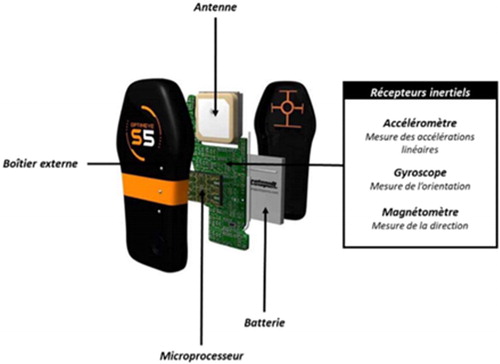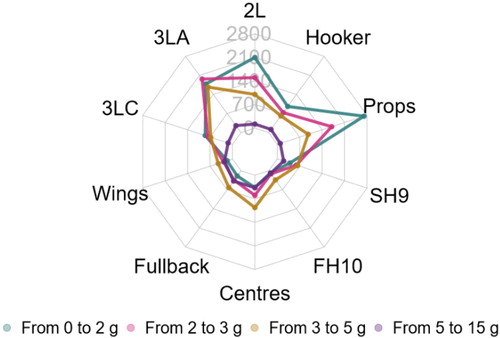1. Introduction
Rugby Union is a collective sport where athletes endure contacts during different phases of the play (tackles, rucks, mauls and scrums). These events have to be characterised in term of intensity, number and dangerousness while they also influence the physical fitness of the players (Johnston et al. Citation2014) and are sometimes linked to direct or delayed injuries (Brooks et al. Citation2005). Brooks and some authors have concluded that rugby union games cause serious damage to the musculoskeletal system. More recently, the risks of damage to the spinal and cerebral nervous structures are also described following the increasing number of concussions recorded (Gabbett et al. Citation2010). Given the importance of the task which involves the safety of the players, the staff devote considerable time to analyse contacts in an attempt to guarantee effective monitoring and to plan training and recovery adapted to the workload and the contacts experienced during training and during matches. Today, GPS (Global Positioning System) including inertial unit (accelerometer, magnetometer and gyroscope) are worn by the players during the match and training. The one developed by Catapult Innovations has been validated by Gabbett et al. (Citation2010) to detect an impact when the body changes orientation (> 60° forward,> 45° left or right,> 30° rear) and that the acceleration varies significantly. Our work is the first attempt at using it to characterise the impacts endured by the players during the 2018 and 2019 seasons of an elite team of the French rugby championship. The purpose of this study is to describe the significant differences in intensity and number of impacts for each position in rugby union in order to determine a risk profile.
2. Methods
2.1. Participants
Data of 35 professional players and 12 academy players of an elite French championship team (Top 14) were collected by the club’s medical and fitness staff with the informed consent of the players. Participants (forward: age = 26.2 ± 4.51 years; mass = 117.5 ± 9.85 kg; height = 190 ± 8 cm, back: age = 25.1 ± 4.24 years; mass = 88, 2 ± 8.3 kg; height = 182 ± 5 cm) provided more than 700 individual match reports (including impact data sought) in 33 Top 14 and European Rugby Championship (ERCC) matches). Each player has provided at least 1 match report and the highest number of reports provided by a player is 29.
2.2. Procedures
All the matches took place between August 25, 2018 and June 8, 2019. They were played on a Saturday or Sunday, on 19 different fields in France, England and Ireland. Each player wore a global positioning system (S5, Innovations Catapult, Scoresby, VIC, Australia, ) in a special pocket of their match jersey located on the upper thoracic spine, between the shoulder blades. The system mass and size were 67 g and 50 × 90 mm, respectively. The accelerometer and gyroscope data were sampled at 100 Hz and the scale range of each axe of the accelerometer’s frame is 0–16 g. Using the 1.22 OpenField software, the outputs of inertial system were ranged in “bands” from 1 to 4 corresponding to the euclidian norm of the 3 D acceleration thresholds between 0–2 g, 2–3 g, 3–5 g and >5 g, respectively.
Each player wore the same measurement device throughout the season's matches. The players were assigned to 9 subcategories (props, hooker, second row (2 L), back row (3 L), scrum half (SH), fly half (FH), center, winger and full back) according to a classification proposed by Quarrie et al. (Citation2013) based on the physical and technical resources requested.
2.3. Statistical analysis
The statistical analysis has been conducted using R (v 3.6.1). The homoscedsticity and normality of the residuals were tested using Bartlett and Shapiro-Wilk tests, respectively. A Kruskal-Wallis test allowed to determine if the means of the impacts’ acceleration ranks were significantly different depending on the positions. A Bonferroni post-hoc test allowed testing the mean differences between the groups. The P value has been set at 0.05 for all the analysis.
3. Results and discussion
The Catapult system has been shown to provide a reliable measure of the number of impacts in rugby in comparison with the video method (r = 0.96, P < 0.01).The measurement is the resulting acceleration during contact between two (or more) players. Cuniffe et al. (Citation2008) found 1274 impacts for a single forward and 798 impacts for a single back. Our count per match reached lower value in forwards (858 impacts) and similar one in backs palyers (830 impacts). The total over our players and matchs reached 28000 impacts.
The Kruskal-Wallis test revealed differences between the means of the positions for each intensity range (X2 Band 1 = 426.16, X2 Band 2 = 262.83, X2 Band 3 = 139.19, X2 Band 4 = 265.53, X2 Total = 226.46, p-value < 2.2e-16).
Low intensity impacts (0 to 3 g) tend to be more frequent among forwards than among backs (< 0.05). Forward players being more often invested in mauls, rucks and scrums, they endure more numerous impacts but the intensity is low because the speed at impact is low. Moreover, the front players are heavier with higher body fat percentage (26.2+/-6%) than the back ones (14.6+/-4%). That could explain a dissipation of the impact in bigger soft tissue mass at the trunk level, close to the measurement unit. On the contrary, backs are more subject to high intensity impacts (5 to 15 g) than forwards. These players are running very fast and can be brutally tackled when running. They also have fitter body shape that do not dissipate energy and may explain a high intensity acceleration at the trunk during the impact. Overall, regardless of the intensity of the impacts, forwards tend to undergo more impacts than backs. Finally, Wings, SH9 and FH10 assuming the strategic transition between forward and back players endure less numerous and lower intensity impacts than the others. This last remark also pinpoints the interest of the collective strategy that directly influences the distribution of the impacts over the team players.
4. Conclusions
The results confirm the hypothesis that the intensity of the impacts varies according to the positions and maybe to the body composition and physical capacity. Indeed, the specificity of the post techniques showing a significant difference between forwards and backs, the impact is also suffered differently by players depending on the impact itself and their body composition. Counting more than 28000 impacts in a season over 47 players of a same team, these parameters have to be included in the physical stress quantification. They also have to be taken into account to plan the longitudinal survey, the training, the rest and the long time management of the athlete career.
Future investigation is necessary to distinguish the dangerousness of the impact looking at the orientation and the intensity so as establishing a link with the medical data of injuries occurrence and severity.
Acknowledgements
The authors report no conflicts of interest in this work.
Additional information
Funding
References
- Brooks JHM, Fuller CW, Kemp SPT, Reddin DB. 2005. Epidemiology of injuries in English professional rugby union: Part 1 match injuries. Br J Sports Med. 39(10):757–766.
- Cuniffe B, Proctor W, Baker JS, Davies B. 2008. An evaluation of the physiological demands of elite rugby union using global positioning system tracking software. Sci Public Policy. 23(4):1–8.
- Gabbett T, Jenkins D, Abernethy B. 2010. Physical collisions and injury during professional rugby league skills training. J Sci Med Sport. 13(6):578–583.
- Johnston RD, Gabbett TJ, Seibold AJ, Jenkins DG. 2014. Influence of physical contact on neuromuscular fatigue and markers of muscle damage following small-sided games. J Sci Med Sport. 17(5):535–540.
- Quarrie KL, Hopkins WG, Anthony MJ, Gill ND. 2013. Positional demands of international rugby union: Evaluation of player actions and movements. J Sci Med Sport. 16(4):353–359.


